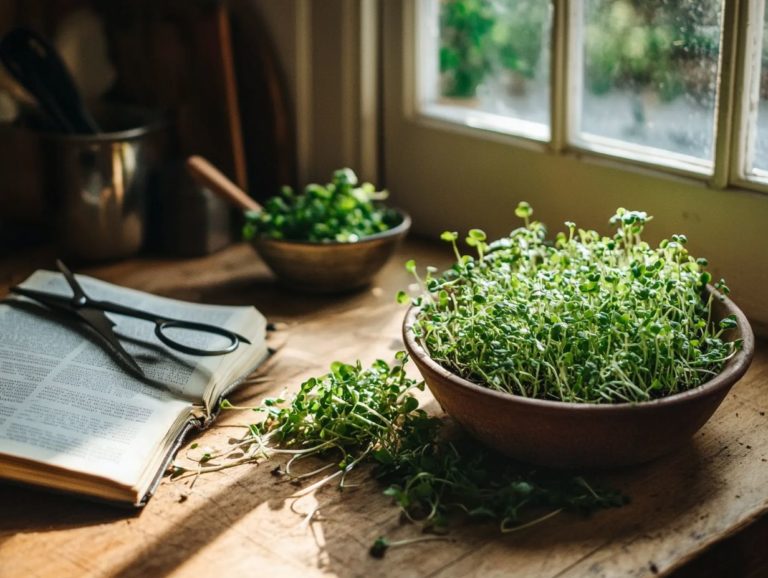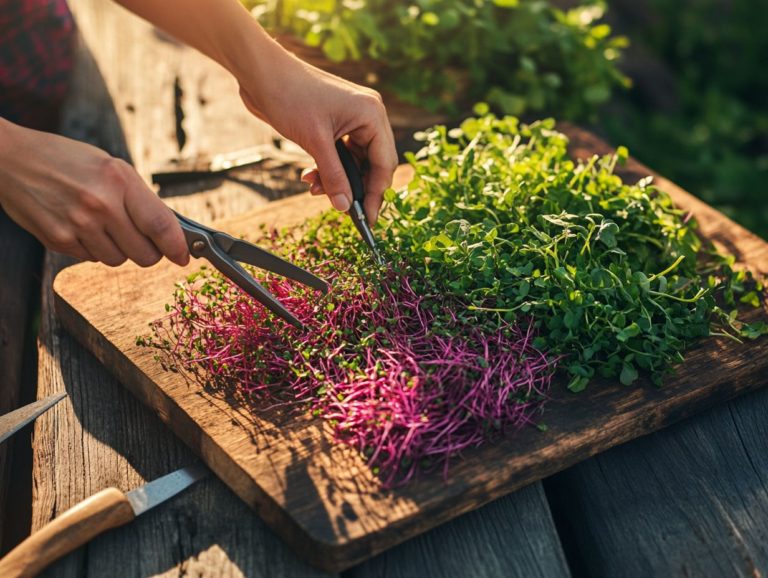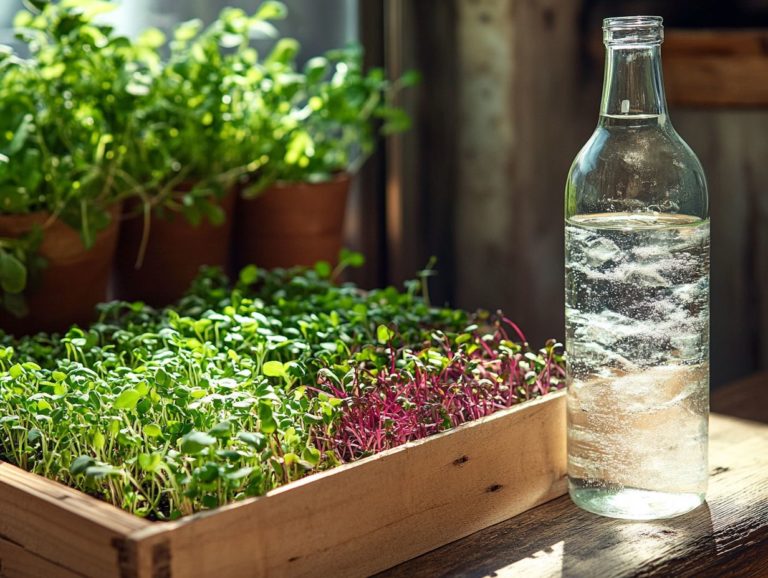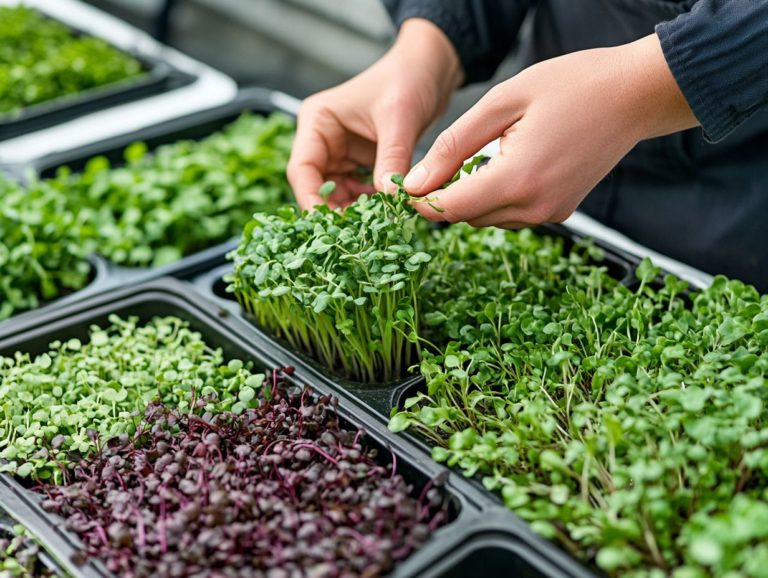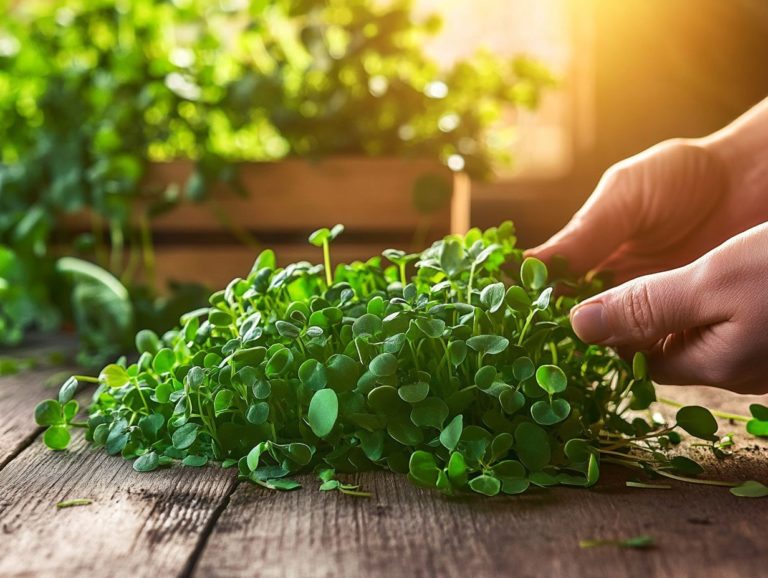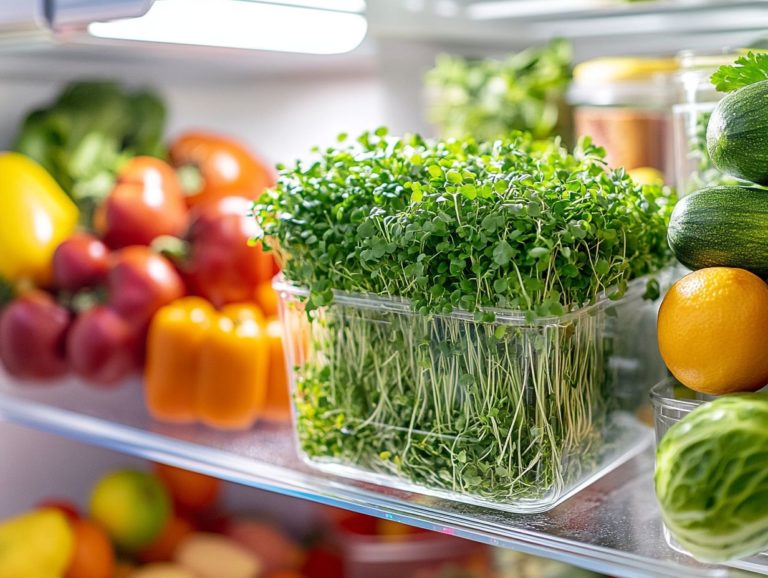5 Reasons to Harvest Microgreens Early
Microgreens have truly revolutionized the culinary landscape, captivating chefs and home cooks alike with their vibrant flavors and remarkable nutritional benefits.
Here are five compelling reasons to harvest microgreens early. These range from maximizing nutrients to enhancing both taste and yield, contributing to a more successful gardening experience. You ll want to discover the optimal timing for harvesting, the crucial growth stages to monitor, and essential tips to sidestep common pitfalls.
Master effective storage methods to keep your greens fresh and flavorful, allowing for better nutritional value. Dive in and unlock the full potential of microgreens!
Contents
Key Takeaways:
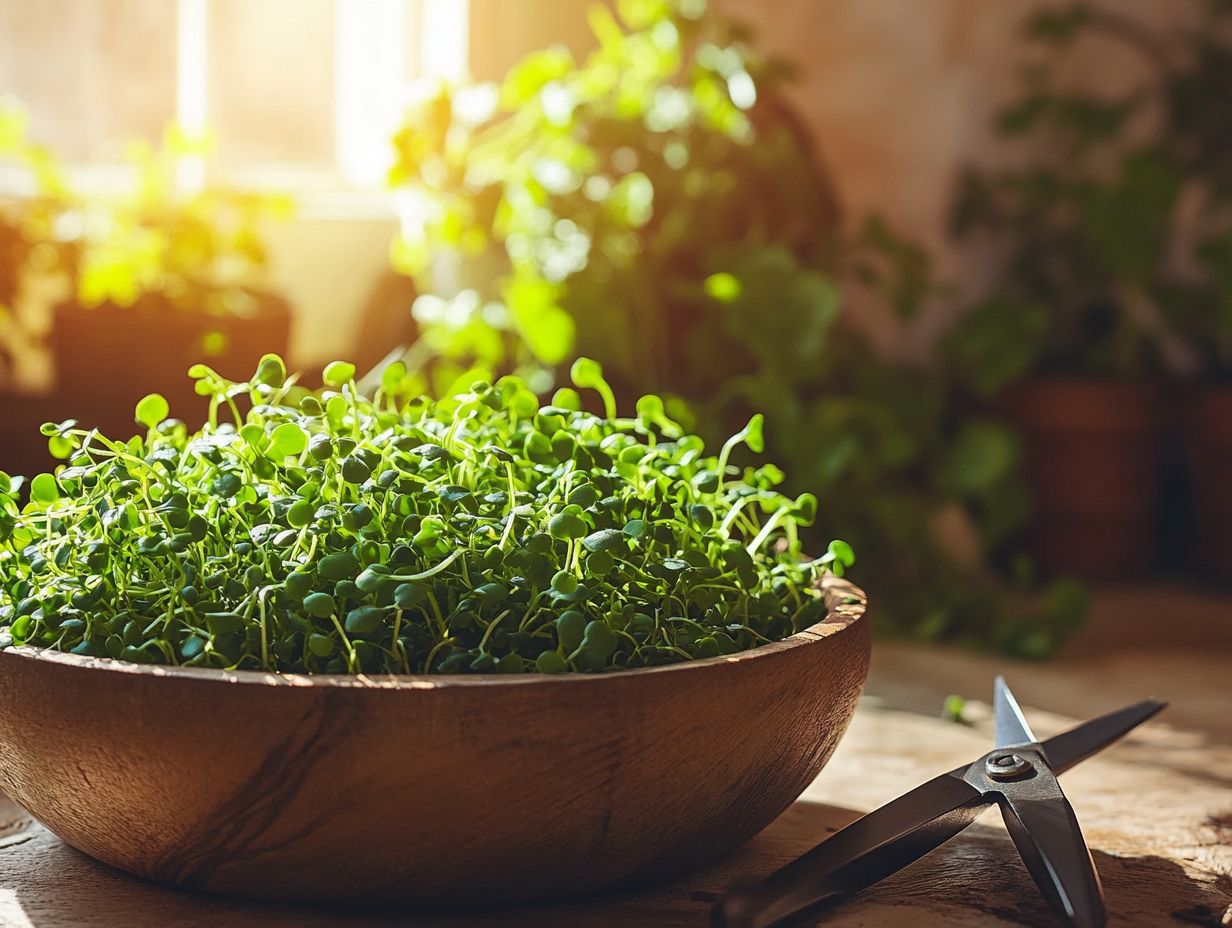
- Harvesting microgreens early increases the nutrient content, making them more nutritious for consumption.
- Early harvest also results in better flavor, as the microgreens are at their peak flavor during this stage.
- By harvesting microgreens early, you can increase yield and have a quicker turnaround time for your next batch, which is especially beneficial for vegetable gardening.
1. More Nutrients
Microgreens are vibrant young vegetables harvested at the leaf stage. They re brimming with an impressive concentration of nutrients.
It s no wonder they re a go-to for health-conscious individuals seeking superfood benefits in their diets. These tiny greens pack a punch when it comes to vitamins and minerals, enhancing the health benefits of your meals.
Take, for instance, broccoli, radish, and spinach microgreens each celebrated for their high levels of essential nutrients. Broccoli microgreens are rich in sulforaphane, a compound linked to improved brain health. Radish microgreens bring not only a spicy crunch but also a bounty of vitamin C, which can help with iron absorption. Meanwhile, spinach microgreens are loaded with iron and magnesium, both vital for maintaining energy levels and muscle function.
Incorporating these nutrient-dense greens into your diet can significantly enhance your healthy eating plan, making them a crucial part of your healthy foods repertoire.
2. Better Flavor
Microgreens offer a treasure trove of nutritional benefits while enhancing the flavor profiles of your culinary creations. These tiny greens bring unique tastes and textures that elevate any dish.
Take arugula, for example; it adds a peppery zing that brightens even the simplest salad. On the other hand, fenugreek introduces a mild, nutty flavor, making it an intriguing choice for sandwiches.
Whether you re a seasoned chef or a home cook, sprinkling vibrant greens atop your entrees can transform an ordinary meal into a gourmet experience.
Incorporating microgreens as a garnish not only boosts the visual appeal of your dishes but also introduces layers of flavor. Pairing a fresh microgreen salad with grilled proteins can completely revolutionize your dining experience.
By blending different microgreens, you can create a complex taste that enhances soups and stews, adding depth and freshness to every spoonful. Cooking with microgreens can elevate your meals.
3. Increased Yield
Engaging in vegetable gardening with microgreens can truly elevate your yield, even in limited spaces. They are perfect for home gardening enthusiasts who prioritize sustainable practices.
These tiny plants boast impressively rapid growth cycles, often ready for harvest in just a couple of weeks. You’ll enjoy fresh, nutrient-packed produce in no time!
The beauty of microgreens isn t just their speed; they also pack a powerful punch in terms of vitamins and minerals, delivering substantial health benefits.
To maximize your yield, it’s essential to invest in high-quality soil rich in nutrients and employ effective pest control measures. This ensures a thriving and healthy crop that can elevate any meal to new heights.
4. Less Risk of Contamination
Growing microgreens, especially with organic seeds and hydroponic systems, greatly minimizes the risk of contamination and health hazards often tied to traditional farming methods. This ensures safer food choices.
By cultivating these nutrient-rich plants indoors, you can create a pristine environment that s free from harmful pesticides and pathogens frequently found in conventional agriculture. The meticulous selection of soil or the choice to forgo it entirely with hydroponics gives you the power to monitor and enhance soil quality.
This effectively eradicating issues related to soil-borne diseases. Indoor settings provide you with superior pest management options, allowing you to use natural deterrents without worrying about chemical residues.
These methods foster safer and cleaner food production while contributing to your overall health by providing fresher options packed with essential vitamins and minerals.
5. Quicker Turnaround Time
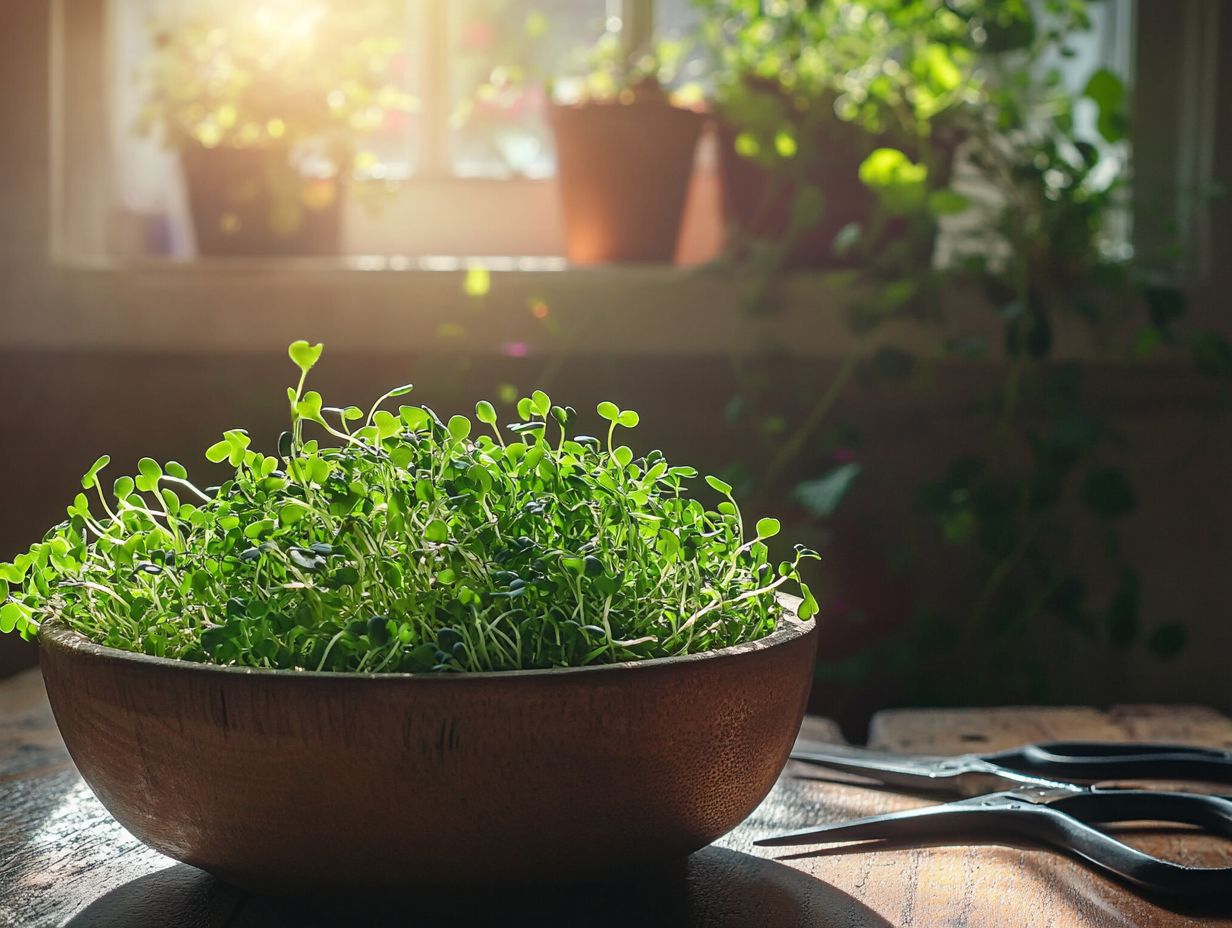
One of the most enticing aspects of microgreens is how quickly they go from seed to harvest. This allows you to savor fresh, nutritious foods while embracing the concept of sustainable gardening.
This impressive speed is largely due to the stage when seeds first sprout, where they soak up moisture and swell, eventually bursting open to sprout. During this critical phase, you’ll want to maintain an optimal environment with consistent moisture and adequate light to promote healthy growth.
Once germination occurs, these little plants quickly develop leaves, leveraging their high surface area to capture light efficiently. Try these easy strategies to speed up growth and enjoy a quick harvest! Consider using a seedling heat mat for warmth and opting for peaty soil to retain moisture.
These simple strategies can lead to a delightful harvest in just two to three weeks, making them a perfect project for educational activities with children.
When Is the Best Time to Harvest Microgreens?
Determining the optimal time to harvest microgreens is essential for maximizing their flavor and nutritional value. You’ll want to pick them right as they reach the true leaves stage to achieve the best taste and texture.
For those passionate about cooking, understanding the ideal harvesting window for different varieties, like broccoli and radish, can dramatically enhance your culinary experience. Broccoli microgreens, typically harvested around 10 to 14 days after germination, provide a mild, earthy flavor. In contrast, radish microgreens, ready in just 5 to 10 days, deliver a delightful spicy kick.
Utilizing proper harvesting techniques is crucial. Wielding sharp scissors to trim the greens just above the soil line helps avoid damage to those delicate plants, preserving their freshness. Get your timing right! Harvest too early and you miss out on flavor.
Harvesting too early may yield bland flavors, while waiting too long can reduce nutrient concentration, ultimately affecting both taste and health benefits.
What Are the Different Stages of Microgreen Growth?
Microgreen growth unfolds in distinct stages, beginning with germination and advancing to the leaf stage, where true leaves emerge this is your cue for harvesting.
During the initial germination stage, it s essential that your seeds receive consistent moisture and warmth, ideally around 70 F, to sprout effectively. Keep the soil damp but not soggy; standing water can invite mold, which is the last thing you want to deal with.
Once your seeds have germinated, they enter the seedling stage, breaking through the soil surface. At this point, light becomes crucial. You should provide strong, indirect light or specific grow lights to prevent stretching, which can weaken your plants.
Keep a keen eye on height and color; vibrant green leaves are a sign of healthy growth. As your plants transition into the leaf stage, nutrient availability becomes pivotal. This is the perfect time to introduce a diluted solution of liquid fertilizer, a nutrient solution that helps plants grow better, to encourage lush, full development.
Regular observation will give you the power to pinpoint the ideal moment for harvesting, ensuring that your microgreens achieve optimal flavor and texture while also maintaining their antioxidant properties.
Start your microgreens journey today and enjoy fresh greens at home!
What Are the Factors That Affect When to Harvest Microgreens?
Several factors influence your decision on when to harvest microgreens, including soil quality, specific growing methods like growing plants in water without soil, and the environmental conditions affecting growth rates.
The quality of the soil is crucial in determining both the speed of growth and the nutritional value of your microgreens. Rich, well-aerated soil filled with essential nutrients leads to more robust plants that are both flavorful and packed with vitamins.
Different harvesting techniques can be tailored to suit the climatic conditions. For example, in humid environments, cutting the greens just above the soil line reduces spoilage. In drier climates, a sharper cut can aid in moisture retention.
This adaptability ensures that each microgreen variety thrives in its unique environment. It ultimately enhances the quality and nutritional benefits of your harvest, making them a favorite among home gardening enthusiasts.
How Can You Tell If Microgreens Are Ready to Be Harvested?
To determine if your microgreens are ready for harvest, pay attention to their growth, especially the emergence of true leaves. This signals that the nutrient concentration and flavor have peaked, maximizing their nutritional benefits.
The size of the leaves offers valuable insights; ideally, they should stand around one to three inches tall and have a vibrant and full appearance. Leaf texture is also essential; a tender yet firm feel often indicates they are ready for picking.
When it’s time to harvest, use clean, sharp scissors to cut just above the soil line. Be careful not to damage neighboring plants. This gentle technique minimizes stress on the microgreens, allowing them to continue flourishing if you decide to leave some behind for a second harvest.
What Are the Common Mistakes When Harvesting Microgreens?
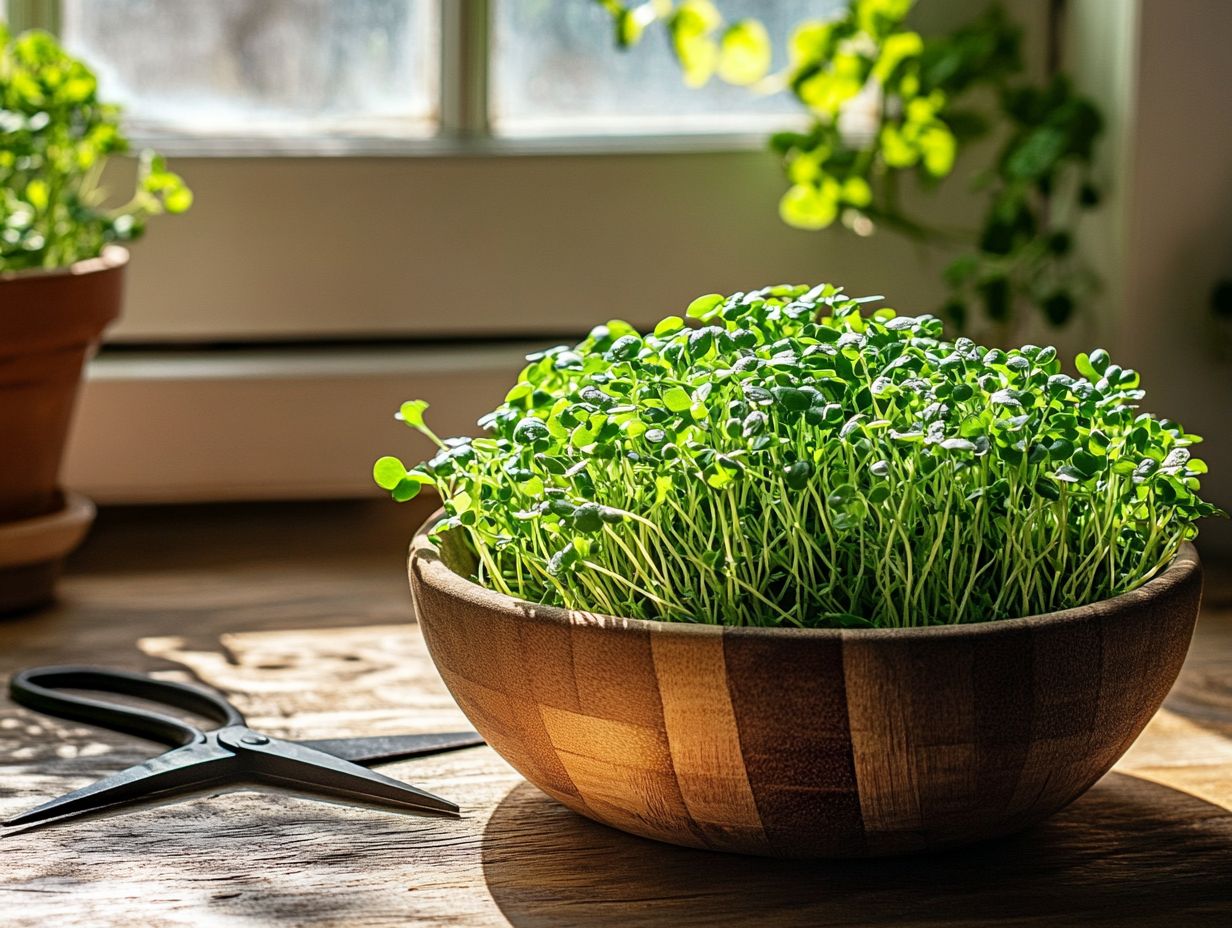
Common mistakes during the harvesting process can lead to a loss of flavor and nutritional value in microgreens, highlighting the importance of proper harvesting techniques, especially in vegetable gardening.
Many novice gardeners cut their microgreens too early, sacrificing rich flavors and essential nutrients. Improper cutting can also damage the roots and disrupt future growth cycles.
Make sure to wait until your microgreens develop their first true leaves for the best flavor and nutritional value. Using sharp, clean scissors ensures a smooth cut, minimizing harm to the plants.
Harvesting in the morning, when the greens are well-hydrated, helps maintain their structural integrity. This guarantees a fresher taste and extends shelf life. By avoiding the top 5 mistakes in growing microgreens and adopting these best practices, you can enjoy the remarkable health benefits that microgreens have to offer!
How Can You Store Microgreens After Harvesting?
Storing microgreens properly after harvesting is crucial for preserving their freshness and health benefits, ensuring they remain a vibrant part of your nutritious meals.
To achieve this, techniques like refrigeration and moisture control can significantly prolong their shelf life. Keep your microgreens fresh by storing them in the fridge! Place them in an airtight container to prevent moisture loss while avoiding excess humidity that can lead to spoilage.
Consider adding these tiny greens to salads, smoothies, or using them as garnishes to fully unleash their flavors and health benefits. They also make your dishes look amazing!
Frequently Asked Questions
What are microgreens and why should they be harvested early?
Microgreens are young vegetables that are harvested just after their first set of true leaves appear. Harvesting them early has several benefits, including their antioxidant properties.
These tiny, edible plants are packed with nutrients. When harvested early, they are more concentrated in essential vitamins and minerals, have a better flavor, and a longer shelf life. Additionally, they possess a more tender texture, making them easier to chew and digest.
What are the 5 reasons to harvest microgreens early?
1. More concentrated nutrients: You consume the plant at its most nutrient-dense stage.
2. Better flavor: Early harvested microgreens have a more intense flavor because their essential oils are at their peak.
3. Longer shelf life: Since they are still in their growing stage, they will stay fresh for longer.
4. More tender texture: These microgreens are easier to chew and digest, which is great for young children or individuals with sensitive digestive systems.
5. More economical: Harvesting them early means you get more value for your money. These greens are still packed with nutrients and flavor!
Can all types of microgreens be harvested early?
Yes, all types of microgreens can be harvested early. However, some may have slightly different optimal harvest times, so it is best to research the specific type you are growing, such as fenugreek or broccoli sprouts.
Is there a specific time of day to harvest microgreens early?
While there is no specific time of day that is best for harvesting microgreens early, it is recommended to do so in the morning when the plants are hydrated and their freshness is at its peak.
How do you know when it’s time to harvest microgreens early?
To know when to harvest microgreens, look for the first set of true leaves. These leaves resemble the mature version of the plant.
These true leaves indicate that the plant is at its nutrient-rich stage. This is the perfect time for harvesting, especially if you’re focusing on health benefits like diabetes management. Act quickly to enjoy the best flavor and nutrients!

